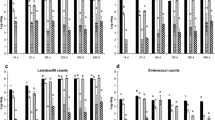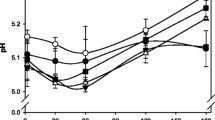Abstract
Physicochemical, proteolysis and textural changes during the refrigerated storage of mature Torta del Casar cheese (a raw ewe milk cheese) subjected to high-pressure treatment (200 or 600 MPa for 5 or 20 min) were studied. Cheeses were analysed after processing at day 60 and after 60, 120 and 180 days of refrigerated storage (days 120, 180 and 240, respectively). High-pressure processing (HPP) had a negligible effect on physicochemical parameters analysed. Nevertheless, nitrogen fractions were significantly affected by HPP. Soluble nitrogen/total nitrogen and non-protein nitrogen/total nitrogen ratios decreased during storage in cheeses treated at 600 MPa compared with control ones. In the same way, proteolysis of casein fractions (para-κ-casein; αs1-CN I, II, III, αs2-CN: αs-caseins; and β1-CN, β2-CN: β-caseins) at day 240 was significantly reduced by HPP at 600 MPa. The levels of αs-caseins and β-caseins found in cheeses treated at 600 MPa and analysed at the end of storage (day 240) were similar to those obtained in control cheeses at day 120 and 180, respectively. Firmness (N) and consistency (Ns) were affected by pressurisation just after HP treatment (day 60), but these changes were reduced during the storage. Therefore, HP treatments at 600 MPa could be a useful tool to delay the Torta del Casar over-ripening associated with an excess of proteolysis during long storage periods.

Similar content being viewed by others
References
Balasubramaniam VM, Farkas D, Turek EJ (2008) By destroying pathogenic and spoilage organisms while keeping food chemistry basically intact, high pressure technology enables pasteurization of foods with minimal effects on taste, texture, appearance, or nutritional value. Food Technol 11:32–38
Ramírez R, Saraiva J, Pérez Lamela C, Torres JA (2009) Reaction kinetics analysis of chemical changes in pressure assisted treatment processing. Food Eng Rev 1:16–30
McSweeney PLH (2004) Biochemistry of cheese ripening. Int J Dairy Technol 57:127–144
Sousa MJ, Ardo Y, McSweeney PLH (2001) Advances in the study of proteolysis during cheese ripening. Int Dairy J 11:327–345
Creamer LK, Olson NF (1982) Rheological evaluation of maturing Cheddar cheese. J Food Sci 47:631–636
Delgado FJ, Rodríguez-Pinilla J, González-Crespo J, Ramírez R, Roa I (2010) Proteolysis and texture changes of a Spanish soft cheese (Torta del Casar) manufactured with raw ewe milk and vegetable rennet during ripening. Int J Food Sci Technol 45:512–519
Garde S, Arqués JL, Gaya P, Medina M, Núñez M (2007) Effect of high-pressure treatments on proteolysis and texture of ewes’ raw milk La Serena cheese. Int Dairy J 17:1424–1433
Voigt DD, Chevalier F, Qian MC, Kelly AL (2010) Effect of high-pressure treatment on microbiology, proteolysis, lipolysis and levels of flavour compounds in mature blue-veined cheese. Innov Food Sci Emerg Technol 11:68–77
Juan B, Ferragut V, Guamis B, Trujillo AJ (2008) The effect of high pressure treatment at 300 MPa on ripening of ewes´ milk cheese. Int Dairy J 18:129–138
Ávila M, Garde S, Gaya P, Medina M, Nuñez M (2006) Effect of high-pressure treatment and a bacteriocin-producing lactic culture on the proteolysis, texture, and taste of Hispánico cheese. J Dairy Sci 89:2882–2893
Juan B, Ferragut V, Buffa M, Guamis B, Trujillo AJ (2007) Effects of high pressure on proteolytic enzymes in cheese: relationship with the proteolysis of ewe milk cheeses. J Dairy Sci 90:2113–2125
Calzada J, Del Olmo A, Picon A, Gaya P, Nuñez M (2013) Using high-pressure processing for reduction of proteolysis and prevention of over-ripening of raw milk cheese. Food Bioprocess Technol. doi:10.1007/s11947-013-1141-5
Official Journal of the European Communities (2002) Publication of an application for registration pursuant to Article 6(2) of Council Regulation (EEC) No 2081/92 on the protection of geographical indications and designations of origin, C 291/2
ISO 5534:2004 (IDF 4: 2004) Cheese and processed cheese: determination of the total solids content
Ardö Y (1999) Evaluating proteolysis by analysing the N content of cheese fractions. Bull IDF 337:4–9
Folkertsma B, Fox PF (1992) Use of the Cd-ninhydrin reagent to assess proteolysis in cheese during ripening. J Dairy Res 59:217–224
Otte J, Ardö Y, Weimer B, Sørensen J (1999) Capillary electrophoresis used to measure proteolysis in cheese. Bull IDF 337:10–16
Recio I, Ramos M, López-Fandiño R (2001) Capillary electrophoresis for the analysis of food proteins of animal origin. Electrophoresis 22:1489–1502
Albillos SM, Busto MD, Perez-Mateos M, Ortega N (2006) Prediction of the ripening times of ewe’s milk cheese by multivariate regression analysis of capillary electrophoresis casein fractions. J Agric Food Chem 54:8281–8287
Feligini M, Frati S, Vlatka C, Bambrilla A (2005) Caprine αs1-casein polymorphism: characterization of A, B, E and F variants by means of various biochemical and molecular techniques. Food Technol Biotechnol 43:123–132
Clément P, Agboola S, Bencini R (2006) A study of polymorphism in milk proteins from local and imported dairy sheep in Australia by capillary electrophoresis. Food Sci Technol 39:63–69
Delgado FJ, Delgado J, Gonzalez J, Cava R, Ramirez R (2013) High-pressure processing of a raw milk cheese improved its food safety maintaining the sensory quality. Food Sci Technol Int 19:493–501
Martínez-Rodríguez Y, Acosta-Muñiz C, Olivas GI, Guerrero-Beltrán J, Rodrigo-Aliaga D, Sepúlveda DR (2012) High hydrostatic pressure processing of cheese. Compr Rev Food Sci F 11:399–416
Saldo J, Sendra E, Guamis B (2001) Hard cheese structure after a high hydrostatic pressure treatment at 50 MPa for 72 h applied to cheese after brining. Lait 81:625–635
Saldo J, Sendra E, Guamis B (2002) Colour changes during ripening high-pressure-treated hard caprine cheese. High Press Res 22:659–663
Rynne NM, Beresford TP, Guinee TP, Sheehan E, Delahunty CM, Kelly AL (2008) Effect of high-pressure treatment of 1 day-old full-fat Cheedar cheese on subsequent quality and ripening. Innov Food Sci Emerg Technol 9:429–440
Koca N, Balasubramanian VM, Harper JW (2011) High-pressure effects on the microstructure, texture, and color of white-brined cheese. J Food Sci 76:399–404
Capellas M, Mor-Mur M, Sendra E, Guamis B (2001) Effect of high-pressure processing on physico-chemical characteristics of fresh goats’ milk cheese (Mató). Int Dairy J 11:165–173
Sousa MJ, Malcata FX (2002) Advances in the role of a plant coagulant (Cynara cardunculus) in vitro and during ripening of cheeses from several milk species. Lait 82:151–170
Fernández del Pozo B, Gaya P, Medina M, Rodríguez-Marín MA, Núñez M (1988) Changes in chemical and rheological characteristics of La Serena ewes’ milk cheese during ripening. J Dairy Res 55:457–464
Marcos A, Fernández-Salguero J, Esteban MA, León F, Alcalá M, Beltrán de Heredia FH (1985) Quesos españoles: Tablas de composición, valor nutritivo y estabilidad, Servicio de Publicaciones de la Universidad de Córdoba, Spain. ISBN:84 600 3969 2
Messens W, Foubert K, Dewettinck K, Huyghebaert A (2000) Proteolysis of a high-pressure-treated smear-ripened cheese. Milchwissenschaft 55:328–332
Saldo J, McSweeney PHL, Sendra E, Kelly AL, Guamis B (2002) Proteolysis in caprine milk cheese treated by high pressure to accelerate cheese ripening. Int Dairy J 12:35–44
Huppertz T, Fox PF, Kelly AL (2004) Susceptibility of plasmin and chymosin in Cheddar cheese to inactivation by high pressure. J Dairy Res 71:496–499
Roseiro LB, García-Risco M, Barbosa M, Mames J, Wilbey RA (2003) Evaluation of Serpa cheese proteolysis by nitrogen content and capillary zone electrophoresis. Int J Dairy Technol 56:99–104
Wick C, Nienaber U, Anggraeni O, Shellhammer TH, Courtney PD (2004) Texture, proteolysis and viable lactic acid bacteria in commercial Cheddar cheeses treated with high pressure. J Dairy Res 71:107–115
Acknowledgments
This study has been financed by the project RITECA II and cofinanced by the Consejería de Empleo, Empresa e Innovación of the Gobierno de Extremadura, by the European Regional Development Fund (ERDF) and by the Programa Operativo de Cooperación Transfronteriza España-Portugal (POCTEP; 2007–2013). R. Ramírez thanks Extremadura Government for her Grant (DOE 22/07/2014).
Conflict of interest
None.
Compliance with Ethics Requirements
This article does not contain any studies with human or animal subjects.
Author information
Authors and Affiliations
Corresponding author
Rights and permissions
About this article
Cite this article
Delgado, F.J., Rodríguez-Pinilla, J., Márquez, G. et al. Physicochemical, proteolysis and texture changes during the storage of a mature soft cheese treated by high-pressure hydrostatic. Eur Food Res Technol 240, 1167–1176 (2015). https://doi.org/10.1007/s00217-015-2420-3
Received:
Revised:
Accepted:
Published:
Issue Date:
DOI: https://doi.org/10.1007/s00217-015-2420-3




